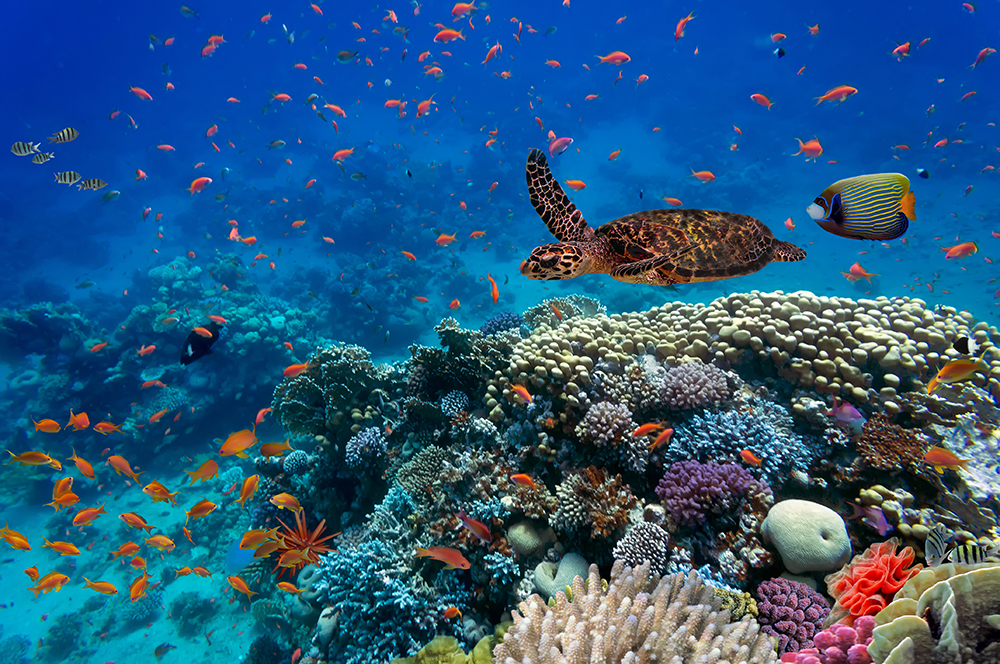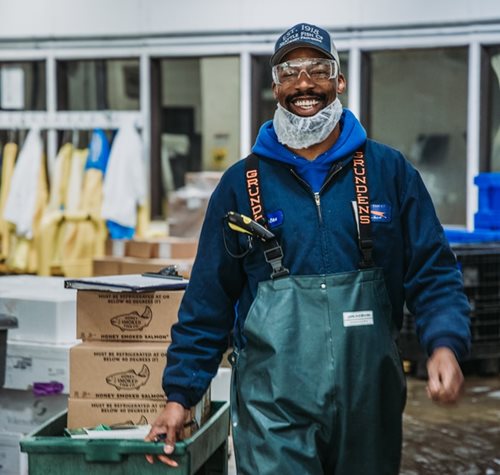Business and Biodiversity
How Companies Can Help Preserve Earth's Biodiversity – and Why They Should
Around the world, biodiversity is decreasing. Pressure on native plants and animals from land development, poaching, and invasive species is causing an uncertain future for many plants and animals. The situation is so pressing that the United Nations has listed preserving life in the oceans and on land as two of its 17 Sustainable Development Goals.
To combat this worldwide decrease, nonprofit organizations, activist groups, and governments have developed numerous preservation initiatives, but despite their efforts, biodiversity continues to be threatened by a growing human population that needs more land and more resources.
Clearly, more must be done to address this crisis. The solution might just lie with an unexpected group: business.

What's Business Got to Do With It?
Corporations might not seem like an obvious choice to join the effort to save biodiversity, since many businesses rely on plant and animal species (and the land they inhabit) to create their products. But new research from College of Business faculty proposes that corporations can play a key role in making the world a better place by preserving Earth’s rich biodiversity – and can improve their bottom lines at the same time.
In “How to pay for saving biodiversity,” a groundbreaking paper published in May 2018 in Science, College of Business Department of Management Professor Tom Dean and his fellow researchers, Edward Barbier and Joanne Burgess from CSU’s Department of Economics and School of Global Environmental Sustainability, assert that corporations have a tremendous amount to gain from preserving biodiversity.
To understand why, it’s important to know the primary causes of species decline: chronic underfunding of preservation initiatives, lack of incentives for global cooperation, and a global failure to control overexploitation and expansion of invasive species.
The burden of funding biodiversity preservation efforts has largely fallen to governments, which often lack the ability to pay for preservation programs or the political will to implement them – or both.
Governments that do undertake preservation initiatives suffer from a free-riding problem that Dean says incentivizes them to “provide less than the optimal level of funding in the hope that others will cover the cost.”
Many countries engage in this type of free-riding behavior, which ultimately reduces global biodiversity. Dean cited Brazil as a recent example.
“The benefit of cutting down the rainforest largely goes to some Brazilians, but the costs are spread across the entire world,” Dean said.
If, as Dean asserts, world governments and nonprofits alone will not be able to solve this crisis, overcoming the funding gap will require direct efforts from an unlikely source: the private sector.
"Destruction of species and habitat has costs on the productive nature of the Earth. Preserving those things has a net positive benefit – it's just a longer-term issue for business." – Professor Tom Dean
Benefits to Business
One of the biggest hurdles to overcome in getting businesses involved in biodiversity preservation is outlining the ways preservation will help the bottom line. Although it is true that for some industries, the benefits of conservation are smaller and accrue over a longer period of time, Dean posits that economic sectors such as seafood, forestry, agriculture, and insurance can benefit directly from supporting conservation efforts.
Dean’s research shows that conserving wildlife could actually increase long-term profits for these industries by expanding their supply of the resources they depend on. For example, protecting coastal wetlands through climate change prevention efforts and land preservation could save the insurance industry as much as $52 billion by reducing losses caused by flood damage.
“Destruction of species and habitat has costs on the productive nature of the Earth,” he said. “Preserving those things has a net positive benefit – it’s just a longer-term issue for businesses. The goal is to make market systems that are more effective with respect to the environment.”
‘Investing in the Future’
To see the ways biodiversity preservation can ultimately improve a business’s bottom line, consider the seafood industry. According to Dean’s research, conserving marine life could boost the industry’s annual profits by more than $50 billion.
Seattle Fish Company Executive Chairman James Iacino (MBA, ’12) agrees that focusing on preservation can boost profitability.
“If we weren’t focused on preserving biodiversity, our ability to continue to buy and sell sustainable seafood becomes nonexistent. Without operating in a forward-thinking and proactive way, we wouldn’t have a business left to stand on,” said Iacino, who is also on the Co llege of Business’s Global Leadership Council. “By investing in the future of our oceans, we are also investing in the future of Seattle Fish Company.”
llege of Business’s Global Leadership Council. “By investing in the future of our oceans, we are also investing in the future of Seattle Fish Company.”
Iacino said Seattle Fish Company’s business model is based on both preservation and conservation. The company actively restores fisheries and is committed to working with partners that are focused on sustainability efforts, which Iacino said will ensure the continuation of the natural cycles of the fishing industry. Seattle Fish is also increasingly relying on land-based aquaculture – breeding and harvesting fish specifically for consumption – as a sustainable way to meet customer demand for fish.
“For being one of the oldest industries around, the world of seafood is seeing a lot of changes as of late,” he said. “Wild fisheries are being overfished at an alarming rate, which is why we see aquaculture as an immediate answer to preserve wild aquatic biodiversity. By leaning on aquaculture to supplement supply, we can take some of the pressure off of wild fisheries.”
Ultimately, Iacino said, it’s important for corporations to do their part to “preserve and restore the environment, not just take.” And as consumers begin to demand responsible, sustainable business practices, companies that are environmentally responsible and transparent about where their products come from are finding greater success than their competitors.
“The customer is ‘waking up,’ and they want more knowledge about what they’re eating,” Iacino said.
“If we weren’t focused on preserving biodiversity, our ability to continue to buy and sell sustainable seafood becomes nonexistent. Without operating in a forward-thinking and proactive way, we wouldn’t have a business left to stand on."
– James Iacino (MBA, '12), Seattle Fish Company Executive Chairman
Preservation at All Levels
Industry and governmental cooperation and investment are necessary to preserve biodiversity on a large scale, but what about conservation on a local level? What can be done to preserve specific species that are endangered or protected but are still sold illegally?
College of Business Management Department Associate Professor John Macdonald has embarked on a three-year research project to examine the ways protected species are illegally traded and identify solutions that will preserve them.
With an $809,000 grant from the National Science Foundation, Macdonald, who specializes in helping companies recover from supply-chain disruptions, will use his expertise to deliberately disrupt illicit wildlife supply chains. Macdonald and his fellow researchers from Michigan State University, Harvard University, the University of Alabama, and the University of Southern California are hoping to create a new understanding of wildlife trafficking supply chains that will help governments and law enforcement disrupt these networks and preserve some of the world’s most vulnerable and valuable species.
Creating Supply Chain Disruptions
Transnational environmental crime – the illegal procurement, transportation, and distribution of natural resource products across international borders – is a thriving industry that depletes natural resources and fuels social conflict around the world. Macdonald is hoping his research can shed light on how these supply chains operate and how they can be dismantled.
 Macdonald will study pangolins, one of the most trafficked animals on the planet.
Macdonald will study pangolins, one of the most trafficked animals on the planet.
The team’s theory is that illegal wildlife trafficking supply chains converge with legal supply chains, making it difficult to detect where trafficked species are coming from and how they move through the supply chain.
“That’s what we want to map: where the entry points are and where they are coming from and going,” he said.
Macdonald and his fellow researchers plan to create a strategic framework for different intervention options and then share those options with enforcement agencies in countries where large numbers of animals are trafficked. By disrupting the supply chain, Macdonald is hopeful that fewer animals will be trafficked, helping preserve vulnerable species from overexploitation.
“For me, simply bringing to life the scale and the scope of illicit trade and trafficking of all types has been interesting,” he said. “[Illicit trafficking] feels like it’s everywhere, but this research is a chance to make the world a better place.”
Message from the Dean
Dean Beth Walker shares the College of Business's mission, vision, and five-year strategic goals.